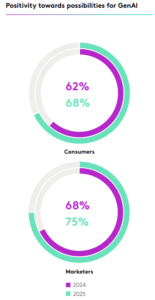The B2B buying cycle has a start and an end, but the path between the two is rarely straight. New research across 632 APAC B2B organisations by Green Hat Marketing shows that buyers are rewriting the rules of engagement, driven by AI, economic pressures, and a younger, digital-native cohort that is reshaping long-standing norms.
For nearly two decades, APAC buyers have been delaying engagement with sellers until later in the journey. This was largely because accessible content made buyers self-sufficient, while Millennials and Gen Zs were only beginning to enter buying teams. Today, that rhythm has changed. Buyers are reaching out almost 12 weeks earlier than last year, contacting vendors when they are only 60% of the way through the journey. Despite evaluating slightly more vendors—an average of 5.5 per deal—the buying teams are smaller, the cycles faster, and the point of first contact has shifted dramatically.
Don’t miss: Report: Over 40% of B2B deals stall due to hidden buyers
Winning the shortlist in a digital-native era
Even with these changes, some truths remain. Buying parties still follow a two-phase journey: the ‘Selection Phase’, where they research, shortlist, and rank vendors, and the ‘Validation Phase’, where they confirm selections, negotiate, and contract. What has changed is the pace.
The average APAC buying journey now lasts 11 months, down from 13, and the average team consists of 11 members. Yet the vendor topping the shortlist at the end of the ‘Selection Phase’ still wins 76% of the time.
In fact, 95% of ultimate winners are on the shortlist from the very start, and 72% of vendors on that shortlist are established on day one. Buyers report prior experience with 73% of day-one vendors, and 80% personally know someone at the vendor organisation. Clearly, the most successful vendors enter the process with a head start.
The younger generation is asserting itself too. APAC buying teams now average between 38 and 44 years old, with Millennials and Gen Zs making up 72% of members. These buyers demand transparency, frictionless information, and fewer interactions with sellers. They have run eight to nine purchase journeys on average within the same category and enter each new evaluation with a clear idea of which vendors to consider.
Interestingly, while digital natives drive much of the push for self-directed research, older buyers have embraced AI tools at similar rates, meaning adoption spans all age groups.
AI’s impact on the B2B buying journey
AI is accelerating engagement, not just enabling it. Almost all APAC buyers report using AI to support their process, with most applications concentrated in the early and middle stages. While buyers have long been confident evaluating vendors independently, AI has highlighted critical knowledge gaps, particularly around the capabilities, costs, implementation, and security of AI-infused solutions.
In fact, nearly half of buyers cite economic uncertainty as a reason to engage vendors sooner, compressing cycles further. Combined, AI and macroeconomic pressures are reversing a two-decade trend of delayed seller contact.
In addition, buyers are particularly focused on understanding how AI is integrated into B2B solutions. They want clarity on functionality, pricing, model training, data storage, and security. With vendor websites often falling short on these topics, direct engagement becomes the only reliable path to insight. This has prompted a noticeable drop in the use of external consultants and analysts, falling from 77% to 56%, and fewer interactions per vendor per person—from 20 to 16. Nearly 58% of buyers report engaging with vendor representatives earlier than they otherwise would to address these AI questions.
APAC in context
While these trends are regional, there are notable sub-regional differences. Singapore buyers place 80% of their shortlist on day one and have prior experience with 91% of vendors, slightly higher than Australasia, Hong Kong, and Southeast Asia. Across APAC, the composition of buying teams remains consistent: requirements are mostly set before vendor contact, and prior experience continues to heavily influence final decisions.
| Region | % of shortlist placed from day one | Winner on day one shortlist | Winner with prior vendor experience | Avg. number of journeys in category |
|---|---|---|---|---|
| Australia / New Zealand | 72% | 94% | 86% | 8.5 |
| Hong Kong | 70% | 92% | 87% | 8.2 |
| Singapore | 80% | 96% | 91% | 9.0 |
| Southeast Asia | 69% | 92% | 88% | 8.3 |
Marketing’s new battlefield
The implications for CMOs are profound. Traditional demand-generation strategies, MQL-focused metrics, and individual-buyer engagement models no longer suffice in this new era dominated by digital-native teams. Winning the ‘Selection Phase’ has become critical; 76% of the time, the preferred vendor at this stage becomes the ultimate winner. Brands must invest in discoverability across search and AI tools, build content that strengthens preference at point-of-first-contact, and rebalance budgets toward brand-building rather than demand-generation.
Account-based marketing is no longer optional. Engaging the entire buying party with persona-based content is crucial, whether for reputational or solution-focused buyers. Thought leadership must be tailored for industries and personas, while sellers need ready-to-go materials to answer questions on AI capabilities, data privacy, security, pricing, and training. Measurement models must evolve, shifting from clicks and MQLs to holistic engagement metrics across the journey, including share of search, buying-party engagement, Marketing Qualified Accounts, and pipeline uplift.
Ultimately, CMOs must ensure that the C-suite understands the new reality: decisions are increasingly made before sales ever enters the picture. Marketing must take the lead in winning the shortlist battleground, guiding the buying party, and opening the gates for Sales to convert. In this fast-moving landscape, adapting to the digital-native, AI-empowered, and economically cautious buyer is no longer a competitive advantage—it’s table stakes.
Related articles:
Study: 94% of B2B marketers in SG struggle to capture audience attention
Report: B2B marketers still struggle to reach the right audiences, but AI may help
Why proving ROI is the new battleground for B2B marketers





